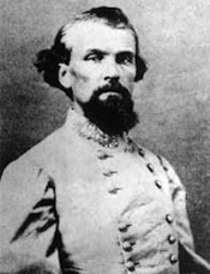
In spite of high rate of casualties, Forrest achieved his objective to pin the Federals behind their fortifications in Jackson, freeing him to continue raids against Union rail and communication lines.
Salem Cemetery, established 1825, experienced a fierce firefight during Confederate Gen. Nathan Bedford Forrest’s West Tennessee Raid of 1862. Alarmed by Forrest’s early success in counties to the east, Federal troopers under Col. Adolph Engelmann were stationed on both sides of Cotton Grove Road in an attempt to slow his progress. On the morning of December 19, 1862, Gen. Forrest's cavalry rode south toward Jackson, unaware of the deadly ambush that lay ahead. As the column approached, Federal soldiers fired a deadly volley of shots, killing or wounding both men and horses.
Forrest’s cavalry retreated to the next ridge to the north, leaving behind dismounted troopers. Using their dead horses for cover, Confederate soldiers returned fire until captured during the ensuing fight. The Federals regrouped behind the cemetery’s iron and wood fence and repelled a brisk cavalry charge, adding to the dead and wounded on the road. Forrest then unlimbered three previously captured artillery pieces and began shelling the Federal position. Because of his cavalry's inexperience with artillery, most of the early rounds went over the heads of the prone Yankees and exploded in the treetops around them.
As the Confederate gunners began to find their range, Col. Englemann, fearing that his outnumbered troops would be surrounded, ordered the withdrawal toward Jackson. Forrest had achieved his objective to pin the Federals behind their fortifications in Jackson, freeing him to continue raids against Union rail and communication lines in West Tennessee.
During the four-hour battle, Confederate losses totaled an estimated 65 killed, wounded, or missing, while Federal losses were 2 killed and 6 wounded.
Tools
Key Facts
- A self-guided tour, Welcome Center, three tour stops, battle map inlay, five monuments and historical cemetery with reference to David Crockett.



